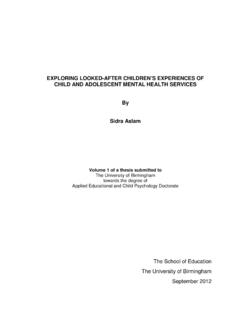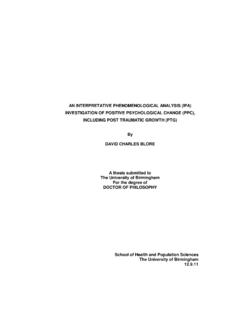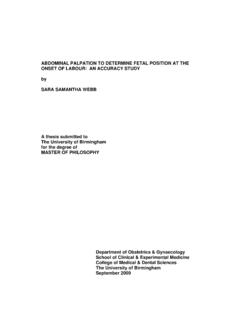Transcription of Insomnia: predisposing, precipitating and …
1 VOLUME I: RESEARCH insomnia predisposing , precipitating and perpetuating factors By Dr Beverley Mari David A thesis submitted to the University of Birmingham for the partial fulfilment for the Doctorate in Clinical Psychology School of Psychology University of Birmingham Edgbaston Birmingham B15 2TT May 2014 University of Birmingham Research Archive e-theses repository This unpublished thesis/dissertation is copyright of the author and/or third parties. The intellectual property rights of the author or third parties in respect of this work are as defined by The Copyright Designs and Patents Act 1988 or as modified by any successor legislation. Any use made of information contained in this thesis/dissertation must be in accordance with that legislation and must be properly acknowledged. Further distribution or reproduction in any format is prohibited without the permission of the copyright holder. OVERVIEW OF DOCTORATE IN CLINICAL PSYCHOLOGY THESIS As partial fulfilment for the degree of Doctorate of Clinical Psychology ( ) at the University of Birmingham, a research and clinical volume are submitted.
2 Throughout the thesis, all identifying information has been anonymised to ensure confidentiality is maintained. Volume I represents the research component. This is comprised of three papers that explore possible precipitating and perpetuating factors involved in the development and/or maintenance of insomnia . The first paper systematically reviews the findings of research implementing non-pharmacological sleep hygiene interventions within a hospital setting. The second paper presents research designed to identify whether the same underlying cognitive mechanisms that have been found to contribute to the maintenance of depression, are present in people who report poor sleep. Both papers will be edited for submission to the Journal of Behavioural Sleep Medicine. The third paper provides a brief executive summary of the literature review and the empirical paper. Volume II represents the clinical volume. This is comprised of five Clinical Practice Reports (CPRs). The first presents a psychodynamic and systemic formulation of an 11-year-old boy presenting with conduct disorder.
3 A service evaluation is presented in the second paper. This evaluates the cygnet parenting program; an autistic spectrum condition parenting support program. The third report presents the case study of Annie who had been admitted to the hospital due to cardiac palpitations. She had presented to staff with low mood and suicidal ideation. A psychodynamic formulation was based on Malan s two triangles model and its development and exploration was integral in intervention. A single-case experimental design report details a six-week Cognitive Behavioural Therapy for insomnia (CBT-I) intervention. Julie presented with a multitude of physical symptoms, particularly related to her multiple sclerosis, but reported her overwhelming fatigue and inability to sleep to be the most difficult. Finally, the fifth report is an abstract for the presentation of a 19-year-old female who was referred to the renal clinical psychology team. Exploring Eleri s depression and anxiety informed a psychodynamic and attachment formulation and intervention.
4 For Leo ACKNOWLEDGEMENTS Sincere thanks go to all my participants. This thesis would be incomplete without you, so thank you for helping make it happen. I'd like to thank my supervisor, Dr Chris Jones, for providing the scaffolding I needed to build this thing. With his genius interludes and unpredictable segues, our research meetings were never boring. (Thanks also to Dr John Rose for a) putting up with all my meetings with Chris, b) for being generally hilarious, and c) for sending me home with fossils for Leo.) Special gratitude goes to Professor Jan Oyebode and Dr Liz Kent for supporting me personally during the course. You are both an example to me. This mountain would have been far steeper had I not been blessed with such great friends around me. I look forward to many more adventures with you. And so, how to thank my family? Mom, Dad, Ceri, Gareth and my amazing Leo, words don't come close to covering this, but let me start with these few: I love you.
5 Volume I: Table of contents i Contents Volume I: Research component I. Literature review: A review of non-pharmacological sleep hygiene interventions in hospital settings. Abstract .. 1 Introduction.. 2 Method .. 5 Quality Review .. 13 Main findings .. 23 Summary of main findings .. 26 Discussion .. 27 Conclusion .. 29 References .. 31 II. Empirical paper: Do people with insomnia show deficits in inhibition and in set switching cognitive tasks? Abstract .. 41 Introduction .. 42 Aims .. 46 Method .. 47 Results .. 53 Summary .. 60 General discussion .. 60 References .. 65 III. Public dissemination document .. 77 IV. Literature review appendices .. 80 V. Behavioural Sleep Medicine author instructions .. 83 Volume I: Table of contents ii Volume I: Appendices I. Literature review .. 80 Appendix 1: Quality Framework Questions (Downs & Black, 1998) .. 81 II. Empirical paper .. 85 Appendix 1: Ethics Approval Letter .. 86 Appendix 2: Information Sheet .. 87 Appendix 3: Participant consent form.
6 89 Appendix 4: insomnia Severity Index .. 90 Appendix 5: Pittsburgh Sleep Quality Index .. 91 Appendix 6: Epworth Sleepiness Scale .. 95 Appendix 7: Pre Sleep Arousal Scale .. 96 Appendix 8: Rumination Scale .. 97 Appendix 9: STAI .. 98 Appendix 10: BDI-II .. 100 Volume I: Table of contents iii Volume I: Figures I. Literature reiew Figure 1: PRISMA Diagram of literature search process .. 6 II. Empirical paper Figure 1 Schematic representation of the Joorman Model .. 46 Figure 2 Example screen shot of the cue screen and the subsequent stimuli .. 49 Figure 3 Mean response time by trial and type and sleep and rumination .. 57 Figure 4: Mean response time for Set-Switching and Inhibition costs by ruminator and sleep groups .. 58 Volume I: Tables I. Literature reiew Table 1: Inclusion and Exclusion criteria.. 5 Table 2: Summary of main characteristics and findings of reviewed papers.. 7 Table 3: Quality review matrix.. 14 II. Empirical paper Table 1: Task types and measures of executive function.
7 50 Table 2: Participant demographic characteristics .. 53 Table 3 Good and Poor Sleep group demographics.. 54 Table 4 Good and Poor Sleep group rumination scores.. 54 Table 5 Good and Poor Sleep group mood scores.. 54 Table 6 Good and Poor Sleep group sleep measures.. 55 Table 7 Differences between high and low ruminators.. 56 Table 8 Pearson correlation. Intercorrelations between self-report of measures .. 56 Table 9 Repeated Measures Analysis of Variance with Effect Sizes and Powers .. 58 Volume II Table of contents iv Contents Volume II: Clinical component I. Clinical Practice Report 1: A Systemic & Psychodynamic Formulation of an 11-year-old boy with aggressive behaviour. Referral details .. 2 Assessment .. 2 Systemic Formulation .. 8 Psychodynamic Formulation .. 16 Critical Appraisal of Models .. 24 Reflections .. 26 References.. 28 II. Clinical Practice Report 2: An evaluation of the Cygnet Parenting Program An Autistic Spectrum Condition Parenting Program. Abstract.
8 34 Introduction .. 35 Evaluation of Cygnet Parenting Support Program .. 42 Method .. 42 Data Analysis .. 46 Results .. 47 Discussion .. 54 Recommendations .. 58 Conclusion .. 59 References: .. 60 Volume II Table of contents v III. Clinical Practice Report 3: That s the thing about mother s love, its unconditional? A Psychodynamic Formulation of a 65-year-old woman with an attachment disorder. Abstract .. 67 Background information and assessment .. 68 Referral information .. 68 Psychodynamic Formulation / Intervention .. 72 Aims .. 72 Evaluation / Outcome .. 84 Reflective practice .. 86 The End .. 88 References .. 89 IV. Clinical Practice Report 4: the minute I turn off the light my mind and pain switch on . The case of Julie and a CBT-I intervention Abstract .. 93 Background information and assessment .. 94 Assessment Process .. 94 Initial thoughts and work .. 99 insomnia .. 100 Formulation .. 107 CBT-I An Evidence Base .. 112 Sleep Disturbance and MS .. 112 Intervention.
9 114 Assessment tools .. 115 Design .. 120 Results .. 122 Discussion .. 126 Personal Reflections .. 129 References .. 130 V. Clinical Practice Report 5: I don t need anyone. The Psychodynamic Formulation of Eleri. A 19-year-old female with an attachment disorder. Abstract .. 140 Volume II Table of contents vi Volume II: Appendices I. Clinical Practice Report 1: Psychological models Appendix 1 - Summary of school observation:.. 142 Appendix 2: Summary of home observation .. 142 Appendix 3: Report of the Strengths & Difficulties Questionnaire .. 143 II. Clinical Practice Report 2: Service evaluation Appendix 1: Five key outcomes identified in the Children Act 2004 .. 145 Appendix 2: Diagnostic Criteria for Autism Spectrum Disorder (ASD).. 146 Appendix 3: Strengths and Difficulties Questionnaire .. 148 Appendix 4 Parenting Scale .. 150 Appendix 5: Being a Parent Scale .. 154 Appendix 6: Depression Anxiety Stress Scales (DASS 21) .. 155 Appendix 7: Scoring key for the Depression-Anxiety-Stress Scales.
10 156 Appendix 8: Confidence Rating Index .. 157 III. Clinical Practice Report 3: Case study No appendices IV. Clinical Practice Report 4: Single case experimental design Appendix 1: SF-36 .. 164 Appendix 2: DBAS .. 169 Appendix 3: ISI .. 170 Appendix 4: STAI .. 171 Appendix 5: BDI-II .. 173 Appendix 6: FSS .. 176 Appendix 7: Sleep V. Clinical Practice Report 5: Case study abstract No appendices Volume II Table of contents vii Volume II: Figures I. Clinical practice report 1: Psychological models Figure 1: Simple Genogram of Zaid's family .. 4 Figure 2: Coordinated Management of Meaning .. 10 Figure 3: Zaid's extended Genogram .. 12 Figure 4: Three-column formulation of Lisa and Zaid s problematic episodes.. 15 Figure 5: The interaction of Malan's two triangles .. 17 Figure 6: Zaid s Triangles of conflict and person .. 18 Figure 7: Lisa s Triangles of conflict and person .. 18 II. Clinical practice report 2: Service evaluation Figure 1: Pre and post median scores for the Strengths and Difficulties Questionnaire.









